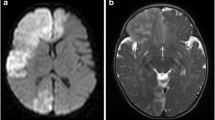Objectives.
To present our clinical experience in terms of disease presentation and choice of revascularisation procedure in our first group of 23 European Moyamoya angiopathy (disease and syndrome) patients.
Method and patient selection. Twenty three patients were diagnosed and treated from 1997–2001 in our neurosurgical department. All patients underwent preoperative angiography, colour Doppler examination, cranial MRI and/or CT scans, HMPAO-SPECT or H 2 15O PET (baseline and Diamox challenge) scans.
Nineteen patients presented with child-juvenile Moyamoya angiopathy with an average age at presentation of 8 years (range 1–17 years), in 4 patients adult Moyamoya was diagnosed with a mean age at presentation of 34 years (range 23–40 years).
Results. In all but one patient bilateral affection was present at the time of diagnosis. All patients underwent direct and/or additional indirect revascularisation procedures. Twenty-one patients underwent bilateral revascularisation procedures. In two patients a unilateral procedure was performed.
A direct STA-MCA bypass (superficial temporal artery branch – middle cerebral artery branch anastomosis) was performed in all patients. Additional direct STA-ACA bypass (STA – anterior cerebral artery branch anastomosis) was performed in 10 patients. Indirect arteriosynangiosis using the occipital artery was performed in the posterior cerebral artery (PCA) territory in 3 patients. The frontal branch of the STA was used for arteriosynangiosis in the frontal region in another 2 patients. Indirect frontal durasynangiosis was performed in 14 patients. The number and location of multiple revascularisation procedures was determined according to the angiographic findings as well as the site of decreased perfusion reserves seen on H 2 15O PET. A one stage revascularisation procedure was performed in 7 patients. Fourteen patients underwent two stage procedures. Following operation no complications were encountered in all but one adult patient who died postoperatively due to a massive middle cerebral artery infarct on the nonoperated side.
Conclusions. As territorial hemodynamic disorder seems to be a characteristic in Moyamoya disease and/or syndrome, judging from our experience with European patients in our series, and several reports hitherto, treatment with multiple revascularisation procedures is considered to be justified.
Similar content being viewed by others
Author information
Authors and Affiliations
Rights and permissions
About this article
Cite this article
Khan, N., Schuknecht, B., Boltshauser, E. et al. Moyamoya disease and Moyamoya syndrome: experience in Europe; choice of revascularisation procedures. Acta Neurochir 145, 1061–1071 (2003). https://doi.org/10.1007/s00701-003-0148-5
Received:
Revised:
Accepted:
Published:
Issue Date:
DOI: https://doi.org/10.1007/s00701-003-0148-5




